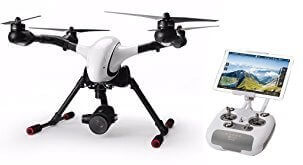Chinese drone manufacturer, Walkera, has become a major player in the industry and to celebrate their twelve years of developing UAVs, they released an update to their successful Voyager line.
The Walkera Voyager 4 has been making rounds in media circles for months now before finally becoming for sale to US consumers. Competitively priced at $3,000, the drone is set to be a unique pick for advance enthusiasts and even for professional use.
Temper your excitement with this Walkera Voyager 4 review that walks you through the highlights of these UAVs.
Unboxing a Beauty
It’s a beautiful drone right out of the box. The raised fuselage leveling with the X-shaped layout of the rotors gives the drone a sleek look. Compared to the Voyager 3, the newer version appears sturdier and lighter.
Walkera Voyager 4 with F8W Transmitter with 4K 18x Camera GPS RC Quadcopter Drone RTF
What makes this drone special, however, is the powerful zoom lens on the camera. Instead of the regular wide-angle lens, this one is equipped with a telephoto. With Voyager 4, you can get 18x zoom right out of the box. Major drone brand DJI previously developed the Zenmuse Z3, but that camera had a zooming power of only up to seven times.
Ships with an Excellent Controller
The controller is a success in many aspects and has made reviewing the Walkera Voyager 4 such a pleasure. The form factor is very ergonomic and rubber grips resulted in a comfortable hold. A 5.8 Ghz signal links the controller to the drone, streaming 4K videos flawlessly. A 3,000mAh built-in battery makes charging the controller easy.
Other than interface for the flight, a separate but smaller joy stick controls the camera’s zoom, as well as the gimbal movement. Clever knobs for switching between flight modes are easy to reach while in operation. Like other drones in this price range, a dedicated Home button sends the drone to its launchpad.
A Solid Flyer
During test flights for this Walkera Voyager 4 review, the drones delivered what it promised on paper. The remote has a respectable range of 1.5 kilometers and has no problem communicating with the drone. The strong signal also streamed 4K video to the iOS app flawlessly.
Regarding flight, the Voyager 4 shows Walkera’s experience in drone design and manufacturing. Versus its predecessors, minor improvements accounted for a better overall experience. For example, the landing gear is now thicker and sturdier than that of the Voyager 3. It also deploys and retreats smoothly.
The four 330kv motors don’t have a problem lifting the 3.2kg drone at any time during this Walkera Voyager 4 review, even in moderate winds and sharp turns. Altitudes are maintained, and flights are smooth. With precision controls, this is one easy drone to fly. Built-in GPS showed no problems following pre-programmed flight paths.
One thing worth noting is that the 18x zoom can have limited applications in flight. Due to the level of zoom, the shaking of the camera can immensely decrease the quality of the footage. In contrast, on zoom tests done on the ground, the camera performed flawlessly, sliding from wide angle to super zoom in about two seconds.
Another Win for Walkera
Solid construction and a zoom that’s hard to match is a worthy update to an already successful drone line. Although it is an exciting feature, it’s hard to imagine a lesser zoom being a deal-breaker at this point. Admittedly, even an advanced pilot might just overlook the telephoto, considering the camera shake on the in-flight footage. But this Walkera Voyager 4 review ends on a positive note.
Despite these minor fallbacks, Walkera highlights that there is nothing quite like a “Flying Telescope”. The superzoom, considering the $3,000 price tag, can definitely find its own league of fans as a speciality product.

